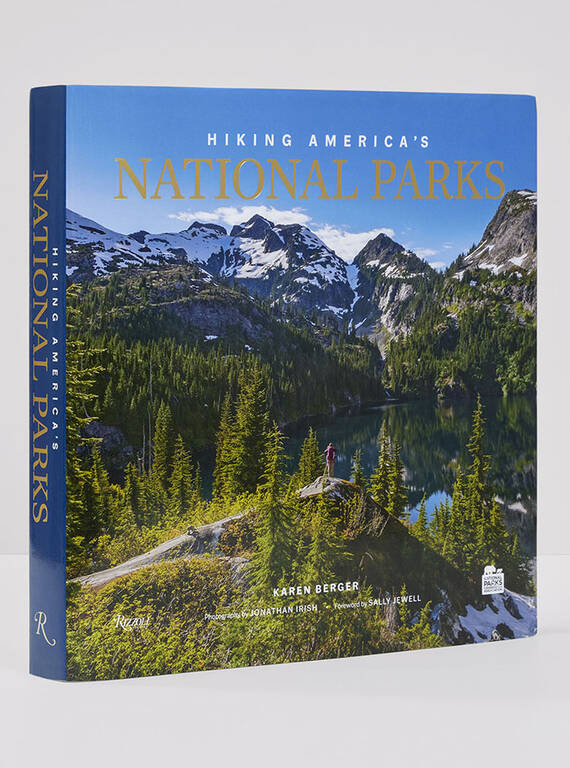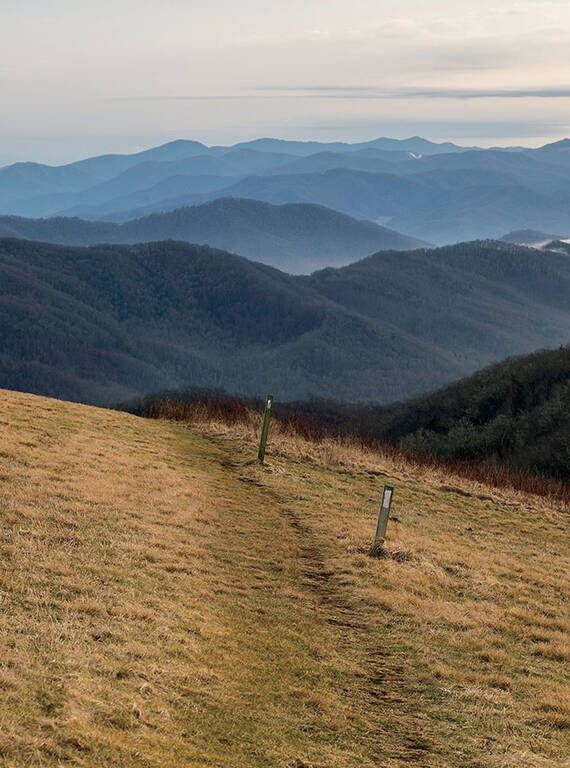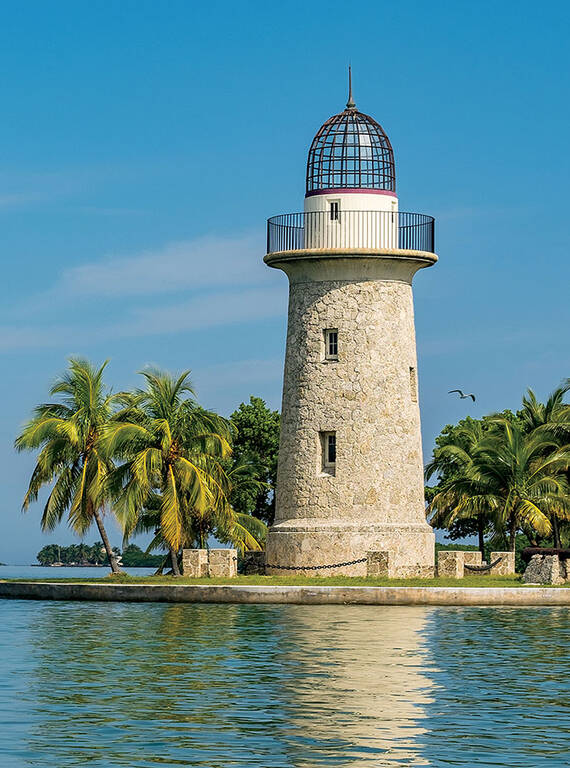From half-mile nature walks on accessible boardwalks to strenuous full-day hikes and backpacking adventures, this new book has information for all skill levels. Or, you can just sit back and enjoy the pictures.
This spring, NPCA and Rizzoli published a new hardcover book — “Hiking America’s National Parks” — with 384 pages of stunning photography and detailed information for people of all hiking abilities. Each of the book’s chosen hikes showcases what is possible: trails that are long, short, hard and easy over terrain as diverse as the continent has to offer.

“Hiking America’s National Parks,” published in 2023 by Rizzoli and NPCA.
RizzoliKaren Berger, who has hiked thousands of miles of national park trails over the past 30 years and written 20 books, is the author. Jonathan Irish, who documented all of America’s national parks for the 2016 National Park Service Centennial, among his other work on seven continents, was the book’s photographer.
I asked Berger about “Hiking America’s National Parks” and why it’s a must-read (and -view) for park lovers. Our conversation has been lightly edited for clarity.
Q: What do you love most about our national parks?
A: I love that each park is unique and has its own character, scenic highlights and history. I love that they are relatively inexpensive, which makes them accessible. I love that they aren’t over-developed with amusement parks and gimmicks that distract us from the landscape, which is the star of the show. I love that their core values include conservation and protection for the future.
Q: In the book’s introduction, you write that trails allow us to be in touch with the land — “to feel it, hear it, smell it” — and offer an opportunity to walk away from our country’s political extremes and ongoing pandemic. What role did these current events play, if any, in why you chose to publish this book now?
A: The timing did seem perfect because I started thinking about the book during the worst days of the COVID-19 pandemic. I think Americans discovered their inner outdoorsperson during that time: kids’ sports were canceled, school was canceled, indoor activities were canceled — but the outdoors was not canceled, and it was perceived as safe. So, people who had never walked beyond the pavement found skis and snowshoes and hiking boots and bicycles and headed to our rural areas and forests — and our national parks.
It’s one thing to drive into a national park and take selfies at a viewpoint. It is quite another to don a pair of hiking boots and throw on a backpack and walk away … and gasp at what lies ahead.
I got to see this up close and personal because I live only a couple of miles from the Appalachian Trail — which is itself a national park unit — and the trailheads were packed in a way I’d never seen before. Benton MacKaye, who proposed the idea of the Appalachian Trail about 100 years ago, saw our outdoor spaces as an antidote to industrialization and the increasing pressures of urban lives. His words seem strangely prescient, when he writes, “There would be a chance to catch a breath, to study the dynamic forces of nature and the possibilities of shifting to them the burdens now carried on the backs of men.”
I would say that social media — to which we also turned during the pandemic — has made us increasingly anti-social in some ways, as we hurl emojis and sarcasm and memes and cliches at each other. But when a group of strangers is appreciating the same thing — in this case, nature — I think we focus more on what we have in common than how we are different. And I think we all agree with author and historian Wallace Stegner, who said our national parks are among America’s greatest inventions. I think we need common ground these days, and we have that in the national parks.
Q: You’re an experienced hiker, having logged thousands of miles on national park trails. Do you have a favorite trail — and if so, which one? And for what reasons?
I have a lot of favorite trails, including whatever trail I just happen to be on in the moment. But I hesitate to name a specific one, first, because the true answer is “it depends” (and it is always changing), and second, because I think that we have gotten a bit too hooked on “10 best hikes” bucket lists and the spectacular Instagram shot, and I’d rather give readers a big menu and a lot of description and then have them choose what resonates with them.
I will say that for me personally, my heart lies in big mountains, and I seem to immediately gravitate to the big Western mountain parks; places like Yosemite, Kings Canyon, Sequoia, Glacier, Rocky Mountain, Rainier, Olympic, North Cascades. But there are many other spectacular environments, and the National Park System has trails through all of them.
Each hiker has their own reasons for hiking: they love challenge, or solitude, or big mountains, or they hate climbing, or they love lakes and streams, or islands, or long hard hikes, or short easy hikes, or unique environments like dunes or caves or thermal features. When I was writing this book, I wanted to give a sampling of trails that gave a broad canvas of what the system offers to a wide range of visitors. And I wanted to offer trails that would encourage visitors, from hard-core hikers and athletes to families to people in need of accessibility features, to get out and explore.
Q: In the book, you write that you were first introduced to national parks through icons of national pride, namely the Statute of Liberty and Liberty Bell. Tell us more about that early introduction.
A: I’m an East Coast kid, and where I grew up near New York City, the national park properties that were most accessible were national monuments, or historic sites, or battlefields, or seashores, or recreation areas. The nearest actual national park to me was probably Shenandoah — but that was too far for a family trip. So, we did family trips to Delaware Water Gap National Recreation Area and Cape Cod National Seashore, and I went on summer camp outings to the Appalachian Trail, and on school trips to the Statue of Liberty and the Liberty Bell — all of which are managed by the Park Service. Over time, I think I saw the great variety and range available in the Park System.
Q: How did your interests expand to what you call “big-ticket marquee parks”?
I was getting to know myself and develop my own passions, and one of those was a love for mountains. Perhaps that was from a combination of visiting the Appalachian Trail on top of Mt. Washington in New Hampshire and reading (and ogling pictures of mountains) in too many National Geographic books and magazines. I had a bit of a delay in actually getting myself to big mountains, though, because I went to a university near Chicago, where contour lines on a map are a theoretical concept.
When a group of strangers is appreciating the same thing — in this case, nature — I think we focus more on what we have in common than how we are different.
But a few years after graduation, I had the opportunity to travel to Rocky Mountain National Park for a conference, and that pretty much set my course for me. I honeymooned on the John Muir Trail, and then started ticking off the big Western parks, and even though I still live in the East, my heart keeps hankering for those big Western vistas, and I travel to them every chance I get.
Q: The book includes spectacular, soulful images by photographer Jonathan Irish. Which is your favorite photograph in the book, and why?
A: Asking me which of Jonathan Irish’s amazing pictures is my favorite is even more difficult that asking which is my favorite trail.

Trail along Max Patch, Great Smoky Mountains National Park. An image from “Hiking America’s National Parks,” published in 2023 by Rizzoli and NPCA.
©Jonathan IrishI think what Jonathan did so well was that he showcases the variety of the national parks, not only of landscapes and scenery, but of environments, animals, plants, geologic features like the amazing arches at Arches National Park or the white Sands of White Sands National Park — and he also features some of the human elements of the parks, from historic and archaeological features to people enjoying the parks today on trails, boardwalks, bridges and kayaks.
But I’ll pick one photo that to me captures one of the core ideas of the book. On page 142, in the Great Smoky Mountains chapter, Jonathan has a picture of two Appalachian Trail blazes leading the viewer toward the endlessly undulating mountains. It’s a picture of a national scenic trail (itself a national park) within a national park, and it communicates the idea of infinity by suggesting that if you start following that trail and those blazes into those mountains, you could just keep walking, the landscape changing before you like pages turning in a book you don’t want to put down.
Q: What do you hope readers take away from this work? And must they be hikers to appreciate it?
A: I want readers to take away a sense of the Park System’s grandeur, as well as a sense of how unique each unit of the system is. I want people to know that visiting the national parks is almost an American birthright — albeit one we share with visitors from the rest of the world.

Boca Chita Lighthouse, Biscayne National Park. An image from “Hiking America’s National Parks,” published in 2023 by Rizzoli and NPCA.
©Jonathan IrishBut most of all, I want to push people into going farther and taking a deeper look, because the farther you go and the deeper you look, the more you see and experience and feel. It’s one thing to drive into a national park and take selfies at a viewpoint. It is quite another to don a pair of hiking boots and throw on a backpack and walk away from the front country and come face to face with your first buffalo or reach the top of a mountain pass and gasp at what lies ahead.
Even after as little as a half an hour, in many cases, you’ll find yourself away from the crowds, away from chatter, away from the signs of civilization — litter, music, bustle — and immersed in a completely different experience.
But I would say that yes, the book also speaks to those who are at present traveling in the armchair and imagination mode. In his famous 1960 “Wilderness Letter,” Wallace Stegner wrote, “We need wilderness preserved — as much of it as is still left, and as many kinds — because it was the challenge against which our character as a people was formed. The reminder and the reassurance that it is still there is good for our spiritual health even if we never once in ten years set foot in it.“ I think the same is true of the national parks.
Interested in purchasing “Hiking America’s National Parks”? Learn more
Stay On Top of News
Our email newsletter shares the latest on parks.
About the author
-
 Linda Coutant Staff Writer
Linda Coutant Staff WriterAs staff writer on the Communications team, Linda Coutant manages the Park Advocate blog and coordinates the monthly Park Notes e-newsletter distributed to NPCA’s members and supporters. She lives in Western North Carolina.